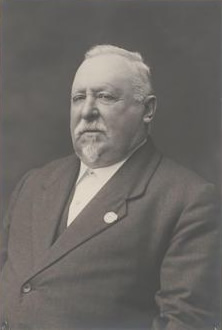ABBOTT, Richard Hartley Smith (1859–1940)
Senator for Victoria, 1928–29 (Australian Country Party)
Richard Hartley Smith Abbott, company director, was born, probably in Bendigo, Victoria, around 1859, the son of Richard Hartley Abbott, also a company director, and Ann, née Smith. The young Richard was educated at Bendigo High School and then at St Andrews, Scotland. Returning to Australia, he became proprietor of the Abbott Supply Company, a director of the Sandhurst Building Society, the Bendigo Gas Company, and several local mining enterprises. He owned farms at Lyell, Mandurang and Eppalock, and was a pioneer of lucerne cultivation and tanning. In 1887, Abbott became a councillor for Strathfieldsaye Shire, a position he held for fifteen years. He was shire president (1901–02) and a Bendigo City councillor (1904–09; 1913–19), serving as mayor of Bendigo between 1917 and 1918.
In 1907, Abbott was elected to the Victorian Legislative Council, but lost his seat at the 1913 election. He regained it in 1922, and held it until he entered the Senate. He chaired the select committee which investigated the management of the Wonthaggi coalfields, and was a member of the royal commission which led to the Commonwealth–state Government agreement on the uses of Murray River water.
The concerns of Abbott’s rural constituency figured prominently in his speeches. ‘If country interests are kept in the van of . . . Government policy’, he insisted, ‘the progress of the city will follow as a matter of course’. Abbott favoured minimal government interference in the activities of the primary producer, claiming that tanning had been ‘absolutely destroyed’ by government over-regulation. He sought to address pollution problems arising from negligent mining operations, objected to ‘the special taxation of land’, and was ‘very doubtful’ about the effects of emancipating women. Abbott advocated the establishment in rural areas of agricultural high schools ‘to promote agricultural education’ while remaining ambivalent about the proposed University of Melbourne Veterinary School, a further example of ‘centralisation’.[1]
Abbott, an early member of the Country Party, was chosen at a joint sitting of both Houses of the Victorian Parliament on 18 December 1928 to fill the Senate casual vacancy created by the death of David Andrew. As he did not stand for election after the expiration of his casual vacancy, Abbott served only until 30 June 1929, but his business and farming experience and his knowledge of parliamentary procedure gained at the state level enabled him to performa useful senatorial role.
The Senate sat for nineteen days during Abbott’s term and he was in attendance for twelve. He spoke on three occasions. His first speech was a brief eulogy on the late Senator Andrew with whom he had been associated in Bendigo. In debate on the Financial Agreement Validation Bill, Abbott was critical of the level of government debt. He drew on his knowledge of state finances, and especially Victoria’s economic situation, to support the financial agreement between the Commonwealth and the states, under which the federal Government would assume responsibility for certain state indebtedness. With the withdrawal of per capita payments by the Commonwealth, Abbott was cognisant of the financial difficulties the states would face if the Agreement was not validated.[2]
Abbott supported the Transport Workers Bill of 1929, which incorporated regulations under the Transport Workers Act 1928; thus preventing alteration of the regulations by government proclamation. The Act had introduced an employee licensing system. Abbott argued that trade union activity in Australia had resulted in high production costs and increased unemployment, and that government licensing restored the freedom which trade unions had taken away from the workers. He outlined his experiences in London during the 1926 General Strike in order to demonstrate the disruptive power of trade unions, arguing that if union domination could be broken similar disturbances might be avoided in Australia.[3]
Abbott had a particular interest in mining, becoming a trustee of the School of Mines and a Fellow of the Royal Geological Society. For many years, he was a member of the Corona and Zenith Masonic Lodges, and a master of the former. On 12 March 1884 at All Saints Church, Sandhurst, Bendigo, he had married, Mary Hannah, née Gibbs.Abbott died on 28 February 1940 at ‘Mandalay’, his home in Rowan Street, Bendigo. His wife predeceased him, but his two daughters,Inez and Alix, and five of his six sons, William, Harold, Kenneth, Jeffrey and Ivan, survived him. His eldest son, also Richard Hartley Smith, predeceased his father by three days. An art lover, Abbott’s services to the Bendigo Art Gallery, of which he had been president, are commemorated by the Abbott Art Prize.[4]
[1] VPP, Progress report of the select committee on the state coal mine, 1910; VPP, Report of the royal commission on the Murray waters, 1910; VPD, 10 February 1909, pp. 57, 58, 26 November 1907, p. 2558, 13 December 1907, p. 3334, 15 December 1910, pp. 3305–3306, 18 November 1908, p. 1422, 30 July 1907, pp. 322–323, 25 February 1909, pp. 531–532, 8 August 1922, p. 538.
[2] CPD, 6 February 1929, p. 14, 14 March 1929, pp. 1196–1198.
[3] CPD, 13 March 1929, pp. 1072–1074, 1081.
[4] Argus (Melbourne), 29 February 1940, p. 1; Bendigo Advertiser, 29 February 1940, p. 4.
This biography was first published in The Biographical Dictionary of the Australian Senate, vol. 1, 1901-1929, Melbourne University Press, Carlton South, Vic., 2000, pp. 327-329.


